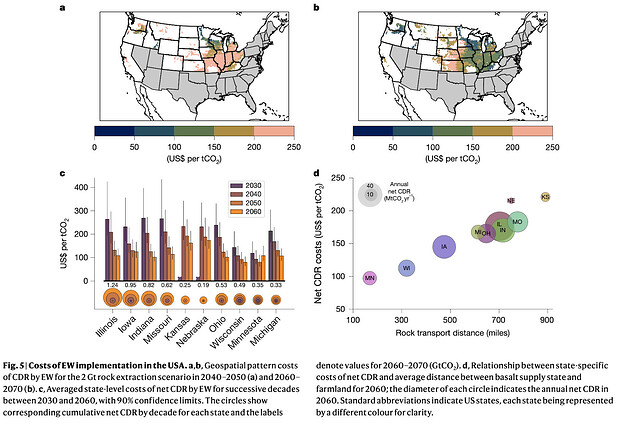This week, we deep dive into the main findings of the paper recently published in Nature. The study was conducted by a team of researchers led by David J. Beerling from the Leverhulme Centre for Climate Change Mitigation of the University of Sheffield, in Sheffield (UK).
This study explores the potential of enhanced weathering (EW) in agricultural settings as a promising but still underexplored carbon dioxide removal (CDR) technology for meeting US decarbonization targets. Indeed, together with the decarbonization of the energy system, the US strategy to reach net-zero emissions by 2050 relies on a large-scale deployment of carbon dioxide removal (CDR) technologies, but the focus has so far been mainly on bioenergy with carbon capture and storage (BECCS) and direct air capture with carbon storage (DACCS). Given the relevance of the agricultural sector in the US context, the authors argue that - if widely adopted on farmlands - EW could significantly contribute achieving net-zero emissions by 2050 and may even temporarily help lower ground-level ozone and concentrations of secondary aerosols in agricultural regions. The study presents an integrated whole-system assessment of feasibility, costs and possible outcomes for soil and air quality of upscaling EW in US agriculture in future decades.
Simulations show that the potential for EW deployment with agriculture could range between 16–30% of the CDR required from CO2 removal technologies. The paper also quantifies the durability of CDR with EW assessing the capacity of US rivers to carry dissolved EW products from soil drainage without extensive release of the CO2 captured, concluding this is unlikely to represent a limiting factor. The analysis of soil biogeochemistry responses to EW shows that average topsoil pH typically remains close to the optimal range of nutrient uptake by major row crops with EW implementation, with some deviations requiring close monitoring after five decades.
Results also show that EW-induced nutrient release rate of crop nutrients like phosphorus and potassium could exceed present average fertilizer rates, and that air quality improvements can be expected, due to the rise in soil pH with EW increasing the ratio of N2 to N2O production during denitrification.
Geospatially mapped CDR costs show marked heterogeneity across the USA reflecting a combination of cropland distance from basalt source regions, timing of EW deployment and evolving CDR rates. The distance factor, given the geography and size of the US plays a key role. As a result, average CDR costs vary between states, being highest in the first decades of EW deployment, when CDR costs will be the lowest in crop states that start EW deployment early; after a few decades, CDR costs will decline as a result of wide adoption and lower energy costs for transportation and rock grinding, with most states achieving CDR at a cost of less than or equal to US$150 tCO2−1.
Here is a list of the main take-aways from this paper:
- Applying crushed silicate rocks to agricultural soils accelerates natural weathering processes, effectively removing CO₂ from the atmosphere.
- EW could sequester approximately 0.16–0.30 gigatons of CO₂ per year by 2050, with potential increases to 0.25–0.49 per year by 2070, depending on implementation scale.
- EW enhances soil pH, reduces dependence on chemical fertilizers, and lowers ground-level ozone, leading to improved soil health and agricultural productivity.
- The initial costs of EW are comparable to other carbon removal methods, with potential for cost reductions over time as the technology matures and scales.
- EW effectiveness and costs vary across different U.S. regions due to factors like soil types, climate conditions, and agricultural practices, calling for region-specific strategies.
- Obtaining a social license to deploy EW equitably is critical, as research on public perceptions reveals a lack of awareness and knowledge of both CDR and EW in the US.
Read the full paper here: Transforming US agriculture for carbon removal with enhanced weathering
